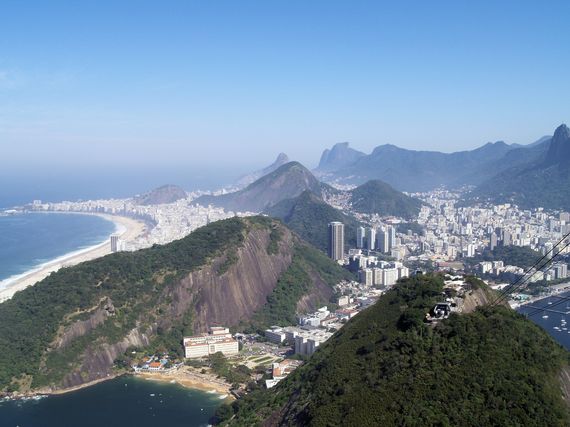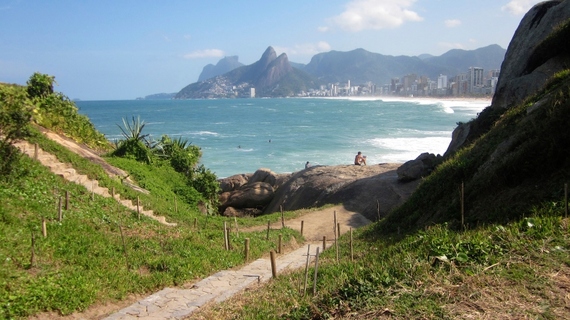Rio de Janeiro, Brazil, is one of the world's top destinations. And for good reason. No other city combines quite the mix of jaw-dropping scenery, world-famous beaches, and laid back cosmopolitan cool, as well as some of the planet's most recognizable landmarks.
There's the towering statue of Christ the Redeemer, the hunchback spine of Sugarloaf Mountain, and miles of white sand beaches whose dramatic mountain backdrops make them among the world's most photographed shores.
This guide to Rio de Janeiro's must-see sites includes all the heavy hitters. But it will also clue you in on the city's lesser-known spots, like a nearly two-century-old library tucked among the downtown skyscrapers, and a secluded observation deck that provides epic views of the city.
Read on to learn more about Rio de Janeiro's top sites, including four you've probably never heard of.
Christ the Redeemer
The first stop on any guide to Rio de Janeiro is Christ the Redeemer. Located on the peak of the craggy Corcovado Mountain, this statue is visible throughout the city. The 1,145-ton monument was completed in 1931. Seventy-six years later, it was named one of the New Seven Wonders of the World, along with the Great Wall of China and Machu Picchu in Peru. To experience Christ the Redeemer, hop on the cog train that takes visitors to the monument's 2,310-foot base for amazing views of the city and beaches below. When you board the train, grab a seat by one of the windows on the right. From here you can see the city peeking through the jungle as you make your ascent up the mountain.
Sugarloaf Mountain
For another scenic perspective of Rio de Janeiro, ride a set of cable cars to the nearly 1,300-foot summit of Sugarloaf Mountain. This is one of the best places in the city to catch the sunset. From here, you can see the sun disappear dramatically behind Corcovado and Christ the Redeemer. At the top of Sugarloaf's famous prehistoric spine is a restaurant where you can order a caipirinha, Rio's signature cocktail of cane liquor and lime, to sip on as you contemplate the view.
The beaches
Grab your smallest swimsuit and plan to spend at least a day on the beach. Rio de Janeiro's shores lure travelers seeking a tan and a taste of local life. Cariocas, as residents of Rio are called, use the beach as a gym, a marketplace and a meeting spot. You'll see them jogging across the sand clad in bikinis and running shoes. Vendors patrol the shores selling everything from sunscreen and sandwiches, to cover-ups and inflatable kiddie pools. Go on a Sunday when the city closes the beachside highways to traffic and promenading families take over the street.
The favelas
Rio de Janeiro is home to about 800 favelas, or shantytowns, that house some of the city's poorest residents. Long a haven for drug gangs, these hillside towns have recently seen a decrease in violence and increase in visitors thanks to the government's pacification efforts. Even though most of the drug lords have been kicked out, it's still not recommended to visit the favelas alone or at night. Find a local guide to help you explore the tangled alleys and understand the complicated history of neighborhoods that for many years didn't receive city services like running water. While you're there, pop into a locally-run restaurant for some of the cheapest and best tasting food in the city.
Jardim Botanico
Commissioned in the early 1800s by the Portuguese Prince Regent Dom João, Rio de Janeiro's botanical garden is home to more than 300 acres of Amazonian plants, exotic gardens and historic monuments. Here you'll see giant water lilies, towering redwoods and, if you're lucky, a monkey or two. The highlight of the park is a stroll between the massive palms that line the park's main trail. Visit on a weekday morning and you'll feel like you have the gardens all to yourself. Just like Dom João did.
Now let's venture off the beaten path to discover a little-known lookout point, as well as a secret spot to relax when you need a break from exploring.
Escadaria Selarón
Chilean artist Jorge Selaron landed in Rio de Janeiro's Lapa neighborhood in the 1980s. For fun, he started decorating the gritty staircase outside of his home with tiles and pieces of porcelain he found in the trash. Within 10 years, the 215 steps were covered with more than 2,000 tiles. As you climb, look for the faces of Princess Diana, Barack Obama and Hindu gods in the tiles around you. The staircase has appeared in music videos, commercials and even in Rio's winning video bid to host the 2016 Olympics, but it rarely gets proper attention in guides to the city.
Mirante Dona Marta
For the best views of Rio de Janeiro's famous sites -- minus the crowds -- head to Mirante Dona Marta. This helipad and lookout point is located off the road from the beaches to the hillside neighborhood of Santa Teresa. From here you can see Sugarloaf, Christ the Redeemer and long strips of the city's white sand beaches. While you're taking in the view, keep an eye out for monkeys and foot-long lizards in the trees around you. Unlike some of Rio's more crowded observation decks, Mirante Dona Marta is extremely cheap. Visitors pay the equivalent of $1 for parking. In comparison, entry to Christ the Redeemer and Sugarloaf costs about $20 per person.
Real Gabinete Português de Leitura
The Portuguese Royal Reading Room was built in 1837 by settlers wanting to honor the art and literature of their homeland in the new colony. Today, it contains thousands of Portuguese books, coins and artwork from the 16th, 17th and 18th centuries. Inside the reading room, wooden bookcases stretch up three stories to an iron chandelier and stained glass skylight. Located on a rough-and-tumble road in Centro, the reading room is a welcome reprieve from the crowds, grit and noise of Rio de Janeiro's downtown.
Arpoador beach
There are songs about Rio de Janeiro's Copacabana beach and a woman who strolled the sands of Ipanema, but the most interesting beach on Rio's main strip remains unsung. Arpoador beach is tucked between its more popular siblings on a rocky peninsula that juts into the Guanabara Bay. In the morning, you'll see fisherman hauling in their daily catch. In the afternoon, surfers ride the waves that break just off Arpoador's rocky shore. Come evening, locals and tourists claim their space on the sun-warmed rocks to watch the day disappear. During midsummer, you can watch the sun set into the sea from Arpoador, a treat considering most of the city's shores face east.
All photos courtesy of Viator





